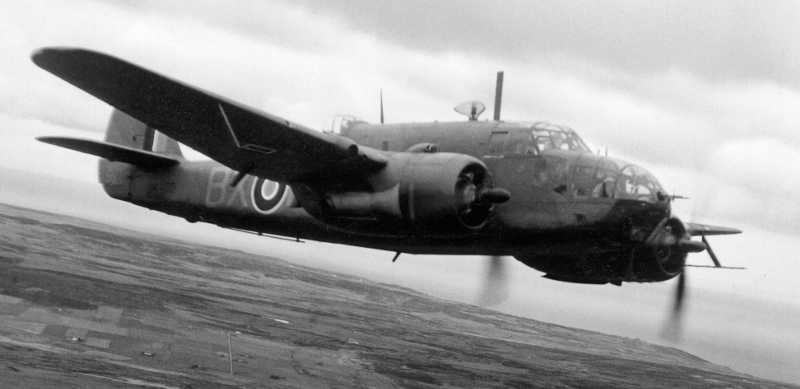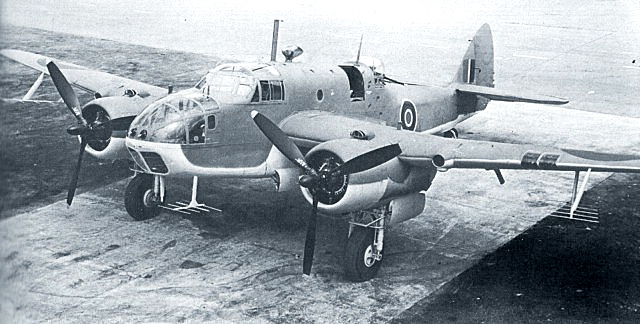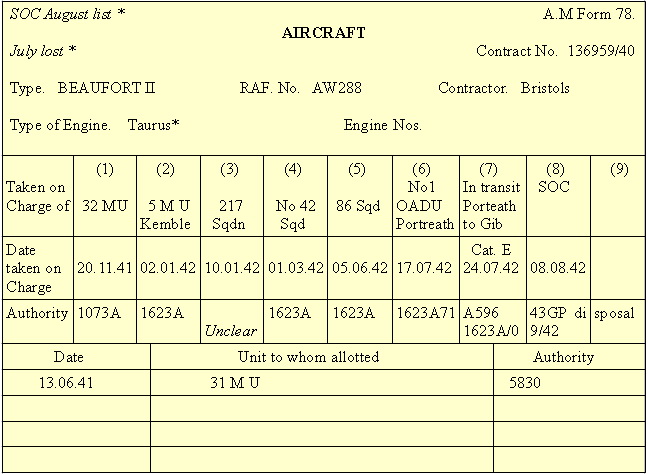
The Bristol Beaufort
This photograph is from the private collection of Chris Clarke.

The Beaufort was hurriedly designed in 1936 to meet Air Ministry requirements for a torpedo bomber and a maritime reconnaissance aircraft. It was derived from the earlier Blenheim light bomber with a longer and deeper fuselage, more powerful engines and an extra crewman. It first flew in 1938 and went into production in 1939, finally entering service early in 1940. The RAF's standard torpedo bomber up until this time was the Vickers Vildebeest, an old biplane. The Beaufort was a huge improvement on the Vildebeest with a top speed of 272 mph compared to the earlier aircraft's 143 mph. However this increase in speed caused an issue with the torpedo. The tactic used on the older plane was to dive toward the enemy and release the torpedo at the bottom of the dive before pulling away. The Beaufort's extra speed made the torpedo hit the water too fast and break up on impact. Fitting dive brakes to the Beaufort proved unsuccessful so the tactic had to be changed. The bomber had to be flown straight and level at a low speed and low altitude for a mile before the torpedo could be released. In many cases this made the plane and its crew a sitting duck for the German ship's anti-aircraft guns and fighter escorts. Later in the war the torpedoes were often replaced with a salvo of rockets carried under the wings - the aerial torpedo didn't quite become obsolete but the dedicated torpedo bomber did.
There was also a tendency in Coastal Command to send the bombers in to attack in line astern with no escort aircraft to provide flak suppression fire or ward off enemy fighters. It wasn't until later in the war that the RAF started to send fighter escorts to attack the ships with machine guns and auto-cannon in order to suppress the anti-aircraft gunfire the Beauforts were facing. Although the Beaufort was never particularly successful against German capital ships it got better results against convoys. After the summer of 1942 it was only used in the Mediterranean and then later in the Far East. A modified version was also built under licence in Australia. After its withdrawal from the front line in Britain it was, almost unbelievably, used to train prospective Mosquito pilots as it was the highest performance twin engine aircraft available until the Mosquito TIII trainer came into service.
The BBC project "WWII People's War" includes a piece by Douglas Young, who was an apprentice working for Folland Aircraft at Hamble near Southampton. The piece includes a paragraph relating how the factory used salvaged parts from crashed Beauforts to build "new" aeroplanes.
Click here for Ben's photos of the Beaufort on display at RAF Hendon.

AW288
The following information has been extracted from the Aircraft Movement Card for AW288. These cards offer a glimpse into the working lives of RAF aircraft. As far as we can tell from the Operational Record Books available and from The Beaufort Files this particular aircraft was never flown on a mission despite having been on the strength of four different squadrons. It had completed the flight down from Scotland without any issues and made a successful test flight the day before the fatal crash.

Many thanks to Mr Andrew Dennis and team at the RAF Museum at Hendon, for kindly providing us with a copy of the original document.
It is worth noting that this document, presumed to be compiled accurately, states that AW288 was fitted with Bristol Taurus sleeve valve engines. Unfortunately the engine serial numbers were omitted when the document was originally raised. This fact conflicts with well documented information that the MkII Beauforts were fitted with Pratt and Whitney Twin Wasp C4 engines.
We contacted the Rolls-Royce Heritage team in the hope that they still held records relating to aircraft production at Filton. Mr Patrick Hassell kindly replied to our enquiry and his answer is as follows:
"...Your enquiry re AW288 has been passed to me. You are right to guess that the Rolls-Royce Heritage Trust Bristol Branch has inherited records from the Bristol Aeroplane Company but, sadly for you, these do not go down to the level of detail you were hoping for. We have volumes of Board Minutes, account books and some Sales ledgers going back to 1910 but from 1943 when the Engine Department became the Engine Division with its own divisional board we have only minutes from that board and nothing on airframe activities.
Your Beaufort would have been built in late 1941 I think as it is the 28th Mk.II and would have been c/n 9916 ( if I have counted right from the data in the Appendix of C H Barnes' "Bristol Aircraft since 1910" ). He says the first production Beaufort II - AW244 - flew at Filton in September 1941. I am surprised the RAFM at Hendon have not been able to tell you which engines it had installed originally as I thought they had record cards for the great majority of RAF aircraft. The BAC records would have been destroyed at some time; we have found notes in the Minutes c.1947 remarking that "several tons" of obsolete records were destroyed with Ministry agreement.
Rolls-Royce inherited the records we do have as a result of the merger with Bristol Aeroplane Company in October 1966. This was the means of bringing Bristol Siddeley and R-R together. R-R bought Hawker Siddeley's 50% share of BS for cash but merged with Bristol Aeroplane Co. This meant the enlarged R-R Group also owned Bristol's 20% of British Aircraft Corporation, as well as the substantial shareholdings in Westland, Shorts, etc. which Bristol owned. Few remember now that for over four years R-R had some responsibility for the Concorde airframe as well as the engines. Bristol shareholders owned about a third of the enlarged R-R Group, and if they kept their shares until 1971 they lost nearly everything of course."